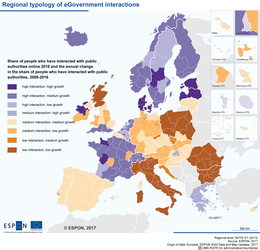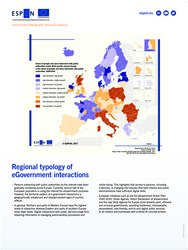Regional typology of eGovernment interactions
- Persons interacting with public authorities via the internet have been gradually increasing across Europe. Currently, around half of the European population is using the internet for eGovernment purposes. However, the territorial pattern of e-government interactions is
geographically unbalanced and displays evident signs of country effects. - In general, Northern and parts of Western Europe have the highest levels of interaction whereas Eastern and parts of southern Europe show lower levels. Digital interactions with public services range from obtaining information to managing administrative procedures and
online voting. This highlights that access to services, including e-services, is changing and requires that both citizens and public administrations have sufficient digital skills. - European initiatives such as the EU eGovernment Action Plan 2016-2020, Urban Agenda, Tallinn Declaration of eGovernment and the new Skills Agenda for Europe strive towards open, efficient and inclusive governments, providing borderless, interoperable, personalised, user-friendly, end-to-end digital public services to all citizens and businesses with a series of concrete actions.
Data sources: the statistical source for the map is the Eurostat dataset “Individuals who used the internet for interaction with public authorities” (isoc_r_gov_i) from the regional digital economy and society database at Eurostat and data estimations coming from ESPON 2020 Data and Map Updates project. (The latter dataset will be made available in April 2018).
Methodology: the map was created by compiling the values of 2016 (percentage) and the growth (percentage points) that were optimized into three classes (high, medium and low) using the Jenks natural breaks classification method.
This map has been used in the ESPON Policy Brief: The territorial and urban dimensions of the digital transition of public services

